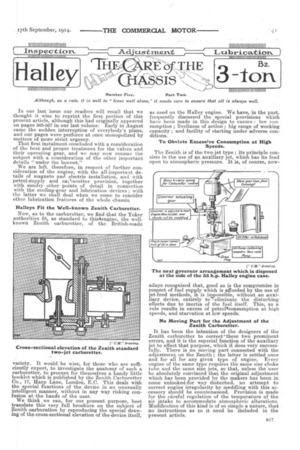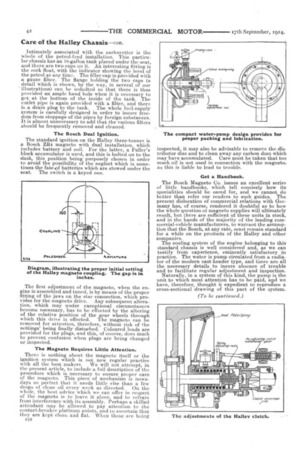In our last. issue our readers will recall that we
Page 5

Page 6

If you've noticed an error in this article please click here to report it so we can fix it.
thought it wise to reprint the first portion of this present article, although this had originally appeared on pages 565-567 in our last volume. Early in August came the sudden interruption of everybody's plans, and our pages were perforce at once monopolized by matters of more strict urgency. That first instalment concluded with a consideration of the best and proper treatment for the valves and their operating gear, and we may now resume the subject with a consideration of the other important details "under the bonnet."
We are left, therefore, in respect of farther consideration of the engine, with the all-important details of magneto and eleetrio installation, and with petrol-supply and cal'auretter provision, together with sundry other points of detail in connection with the cooling-gear and lubrication devices ; with the latter we shall deal when we come to consider other lubrication features of the whole chassis.
Halleys Fit the Well-known Zenith Carburetter.
Now,, as to the carburetter, we find that the Yoker authorities fit, as standard to thisfiengine, the wellknown Zenith carburetter, of the British-made variety. It would.be wise, for those who are sufficiently expert, to investigate the anatomy of such a carburetter, to procure for themselves a handy little booklet which is published by the Zenith Carburetter Co., 17, Harp Lane, London, E.C. This deals with the special functions of the device in an unusually intelligent manner, without in any way risking confusion at the hands of the user.
We think we can, for our present purpose, best translate this very full brochure on the subject of Zenith carburation by reproducing the special drawing of the cross-sectional elevation of the device itself,
as used on the Halley engine. We have, in the past, frequently discussed the special provisions which have been made in this design to ensure : low consumption ; liveliness of action ; big range of working capacity ; and facility of starting under adverse conditions.
To Obviate Excessive Consumption at High
Speeds.
The Zenith is of the two-jet type ; its principle consists in the use of an auxiliary jet, which has its feed open to atmospheric pressure. It is, of course, now
adays recognized that, good as is the compromise, in respect of fuel supply which is afforded by the use of jet-feed methods, it is impossible, without an auxiliary device, entirely to eliminate the disturbing effects due to inertia of the fuel itself. This, as a rule results in excess of petrolvconsumption at high speeds, and starvation at low speeds.
No Moving Part for the Adjustment of the Zenith Carburetter.
It has been the intention of the designers of the Zenith carburetter to correct these two prominent errors, and it is the especial function of the auxiliary jet to effect that purpose, which if does very successfully. There is no moving part connected with the adjustment on the Zenith ; the latter is settled once and for all for any given type of engine. Every engine of the same type requires the same size choke tube and the same size jets, so that, unless the 'user be absolutely convinced that the original adjustment which has been provided by the makers has been in some unlocked-for way disturbed. no attempt to correct engine irregularity by .meddling with this accessory should be countenanced. Provision is made for the careful regulation of the temperature of the air intake to accommodate atmospheric alterations. Modification of this kind is of so simple a nature, that no instructions as to it need be iiicluded in the present article. Intimately .a,ssociated with the carburetter is the whole of the petrol-feed installation. This particular chassis has an 18-gallon tank placed under the seat, and there are two caps on it.. An interesting fitting is the cork float, with the indicator showing the level of the petrol at any time. The filler cap is provided with a gauze filter. The flange holding the two caps (a detail which is shown, by the way, in several of our illustrations) can be unbolted so that there is thus provided an ample hand hole when it is necessary to get at the bottom of the inside of the tank. The cutlet pipe is again provided with a filter, and there is a drain plug to the tank. The whole fuel-supply system is carefully designed in order to insure freedom from stoppage of the pipes by foreign substances. It is almost unnecessary to add that the various filters should be frequently removed and cleaned.
The Bosch Dual Ignition.
The standard ignition on the Halley three-tonner is a. Bosch ZR4 magneto with dual installation, which includes battery and coil. For the latter, a Fuller's block accumulator is used, and this is bolted on to the dash, this position being purposely chosen in order to avoid the possibility of the neglect which is sometimes the fate of batteries which are stowed under the seat. The switch is a keyed one.
The first adjustment of the magneto, when the engine is assembled and tuned, is by means of the proper fitting of the jaws on the star connection, which provides for the magneto drive. Any subsequent alteration, which may under exceptional circumstances become necessary, has to be effected by the altering of the relative position of the gear wheels through which this drive is effected. The magneto can be removed for attention, therefore, without risk of the settings' being finally disturbed. Coloured leads are provided for the plugs, and this, of course, does much to prevent confusion when plugs are being changed or inspected.
The Magneto Requires Little Attention.
There is nothing about the magneto itself or the ignition system which is not now regular practice with all the best makers. We will not attempt, in the present article, to include a full description of the procedure which is necessary to ensure, proper care of the magneto. This piece of mechanism is nowadays so perfect that it needs little else than a few drops of clean oil every week as directed. On the whole, the best advice which we can offer in respect of the magneto is to leave it alone, and to refrain from interference with its assembly. Perhaps a skilled attendant may be allowed to pay attention to the contact-breaker platinum points, and to ascertain that they are kept clean and flat. When the,se are being inspected, it may also be advisable to remove the distributor disc and to clean away any carbon dust which may have accumulated. Care must be taken that too much pit is not used in connection with the magneto, as this is liable to lend to trouble.
Get a Handbook.
The Bosch Magneto Co. issues an excellent series of little handbooks, which tell concisely how its specialities should be cared for, and we cannot do better than refer our readers to such guides. The present dislocation of commercial relations with Germany has, of course, rendered it doubtful as to how the whole question of magneto supplies will ultimately result, but there are sufficient of these units in stock, and in the hands of the majority of the leading commercial-vehicle manufacturers, to warrant the assumption that the Bosch, at any rate, must remain standard for a while on the products of the Halley and other companies.
The cooling system of the engine belonging to this standard chassis is well considered and, as we can testify from experience, eminently satisfactory in practice. The water is pump circulated from a radiator of the modern cast-header type, and there are all the necessary details to insure absence of trouble and to facilitate regular adjustment and inspection.
Naturally, in a system of this kind, the pump is the unit to which most attention has to be paid, and we have, therefore, thought it expedient to reprodUce a cross-sectional drawing of this part of the system.






















